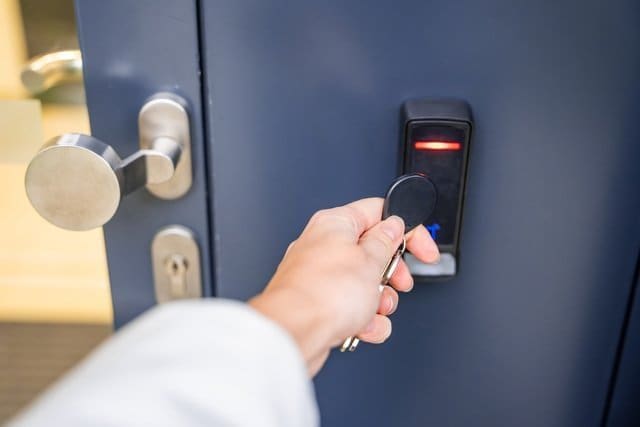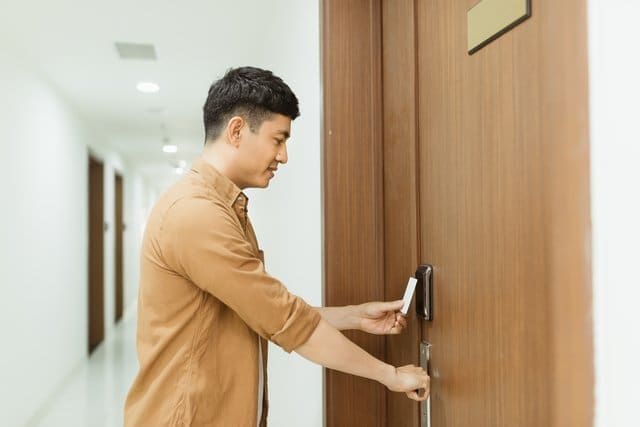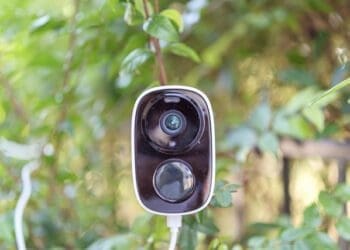In the modern business world, ensuring the security of commercial buildings is of paramount importance. One of the most effective ways to safeguard assets and restrict access to sensitive areas is by installing reliable digital door locks.
These electronic keypad door locks offer enhanced security compared to traditional mechanical locks, providing businesses with greater control over access and monitoring capabilities.
Installing a digital door lock system can streamline access control, eliminate the need for physical keys, and offer advanced features like touchpad controls, fingerprint readers, and built-in sensors. Choosing the right commercial electronic locks tailored to your business’s specific needs is crucial, as they come in various types and models with different functionalities.
This guide aims to compare the best digital door locks for commercial buildings, covering key features, popular brands, differences from other lock types, installation processes, and user guides.
Top Features to Look For in Keypad Door Locks

When it comes to controlling access within your building, choose a solution that’s easy to use without compromising security. One popular option is installing commercial keypad door locks.
A commercial keypad door lock is a type of keyless lock that lets you control which tenants and staff can enter a building or room. These locks have a numerical keypad (or touchscreen interface with numbers) in place of traditional keyholes.
Security Features
Keypad locks are just as safe as key locks. They offer improved security features that allow them to keep unauthorized individuals out and valuable possessions secure. Commercial electronic door lock systems are a big step up from traditional mechanical locks, like mortise and cylindrical locks.
They’re generally easier and more convenient to use. Also, electronic locks have built-in fail-safe or fail-secure technology so that they work even in the event of a power outage.
The use of encrypted communication makes it possible for business keyless entry systems to verify unique credentials. Not only that, but these devices can keep track of all door entries and give detailed reports.
This information could help improve how the room is managed and could give important clues in the event of an investigation into security or human resources.
User-Friendliness
Commercial keyless door locks are the pinnacle of convenience because they eliminate the need for physical keys. In fact, keypad locks even eliminate the need for physical credentials altogether! Since keypad door locks are a type of keyless entry solution, tenants can unlock the door without keys, fobs, or cards.
All they need is a PIN code, so there’s nothing they need to worry about carrying in their pockets.
When it comes to the functionality of a keypad lock, tenants are less likely to be locked out due to a lost or forgotten key. Also, they’re less likely to have their keys stolen by criminals.
This is because physical keys tend to be hidden in not-so-secret spots, like under the doormat. All tenants need is their smartphones or PIN codes to enter — which are much less likely to be stolen.
Commercial keypad locks offer a more convenient and secure alternative to traditional key-based entry systems. With these locks, you can regulate access to your business premises more quickly and with more security.
Also, you won’t have to worry about the risks associated with lost or stolen keys.
Popular Models and Brands

When it comes to popular models and brands of digital door locks for commercial buildings, several options stand out for their features, security, and user-friendliness.
Model-Specific Features
According to expert reviews, the Yale YRD256 Assure Lock SL is highly praised for its ease of programming, customizability, and sleek design. The lock features a touchscreen interface that stays blank when not in use, preventing fingerprint smudges on the code numbers.
The backlit numbers are easy to read, and the lock rarely misses inputs, even when wearing gloves. Programming is straightforward, with voice prompts guiding the process.
Customization options include volume settings, language preferences, and auto-lock durations.
For those seeking a high-security grade lock, the Schlage BE365 Keypad Deadbolt is a top choice, boasting the highest ANSI Grade 1 rating. While bulkier in design, it offers a traditional keyway for backup access and satisfying tactile keypad buttons.
The pronounced buttons are spaced apart, making them glove-friendly, and a backlight illuminates the numbers in low-light conditions.
The Trilogy DL6100 is a versatile option, combining a door lock supporting up to 5,000 users with 3- or 6-digit PINs and network capabilities for remote locking/unlocking. It can also attach time and date stamps to up to 35,000 events, making it a comprehensive solution for commercial facilities.
Customer Ratings and Reviews
Customer reviews highlight the Yale YRD256 Assure Lock SL’s user-friendly interface, easy programming, and customization options as standout features.
The Schlage BE365 Keypad Deadbolt is praised for its high-security grade and the added security of a traditional keyway, despite its bulkier design.
The Trilogy DL6100 is commended for striking a balance between basic lock functionality and advanced features like wireless capabilities and detailed event logging, making it a popular choice for commercial facilities.
Other highly-rated options include the Trilogy T2 DL2800, Kaba E-Plex, and Yale YRC216, each offering a unique combination of features, user capacity, and integration with existing systems.
Overall, customer feedback emphasizes the importance of user-friendliness, security features, durability, and compatibility with existing infrastructure when selecting the best digital door lock for commercial buildings.
Key Differences Between Keypad Door Locks and Other Types
Commercial keypad door locks offer several key advantages over traditional mechanical locks and differ in functionality from smart locks. Here are the key differences:
Comparison with Traditional Locks
Commercial keypad door locks are a type of keyless lock that lets you control which tenants and staff can enter a building or room. These locks have a numerical keypad (or touchscreen interface with numbers) in place of traditional keyholes.
Unlike traditional mechanical locks, like mortise and cylindrical locks, commercial electronic door lock systems are generally easier and more convenient to use.
One significant advantage of keypad locks is that they eliminate the need for physical keys or credentials altogether. Tenants can unlock the door using just a PIN code, eliminating concerns about carrying keys or forgetting them.
This added convenience is further enhanced by the fact that electronic locks have built-in fail-safe or fail-secure technology, ensuring they work even in the event of a power outage.
Fail-safe locks require continuous power to stay activated. In the event of an emergency or building-wide power outage, they deactivate, allowing tenants to quickly pass through without using their credentials. Conversely, fail-secure locks don’t require continuous electricity to stay activated.
Instead, they respond to a single burst of electricity from a tenant’s credentials (such as a key fob). These locks stay engaged if the power goes out, adding more security to the building in the event of an outage.
Furthermore, electronic commercial door lock systems with keypads provide enhanced security compared to traditional locks. Eliminating the need for physical access keys removes any chance of someone losing or copying the key with malicious intent.
Property owners and senior management professionals can alternate the PIN code on a timely basis to ensure only authorized personnel have access to the space.
Comparison with Smart Locks
While both keypad door locks and smart locks offer keyless entry, they differ in their functionality and features. Keypad door locks are a type of keyless entry solution where tenants can unlock the door using just a PIN code, without the need for keys, fobs, or cards.
Smart locks, on the other hand, often integrate with mobile apps or smart home systems, allowing users to lock and unlock doors from their smartphones. Some keypad door locks also offer this smart functionality, pairing with a mobile app to allow users to control door access from anywhere, even off-site.
However, not all keypad door locks are necessarily “smart” in this sense. Some models may offer basic keypad entry without advanced features like remote access or integration with other systems.
Smart locks, by definition, offer these advanced capabilities, making them a more comprehensive solution for those seeking to integrate door access with their smart home or building automation systems.
In summary, while keypad door locks provide a convenient and secure keyless entry solution, smart locks take this functionality a step further by offering remote access, integration with mobile apps and smart home systems, and additional features tailored to modern smart building management.
Installation and User Guides
Step-by-Step Installation Guide
Installing a commercial keypad door lock is a relatively straightforward process that typically involves replacing the existing doorknob and lock.
Here are the general steps to follow:
- 1.Remove the old hardware from the door. For example, “Start by removing the old hardware from the door this particular lock we’re installing today is a smart wi-fi deadbolt allowing the user to enter the code or use their phone to lock and unlock the door”.
- 2.Install the new lock bolt into the door. “Next install the bolt into the door on this particular model note that there is a top and bottom make sure you’re installing it correctly”.
- 3.Mount the keypad on the exterior side of the door. “Follow up by placing the keypad on the outside of the door and feed the wires through the door towards the inside then place the back plate on the inside of the door the keypad is now secured to the door”.
- 4.Connect the wires and secure the lock. “Now it’s time to connect the wires it’s easy to do just insert the two ends together for the wire then slip the back of the device onto the door and tighten with the provided screws to lock in place give the latch a test to make sure it’s able to turn without the entire lock moving”.
- 5.Install batteries (if required). “This model runs on batteries so no need to worry about any electrical work with the installation with the batteries in we’ll put the back plate on to finish the lock installation on this project”.
- 6.Pair the lock with your smartphone (if applicable). “If your phone has wi-fi function to it you’ll follow the manual and app instructions to pair the device to your phone you can have true peace of mind that the door is locked just by checking your phone when you’re away”.
7.It’s essential to follow the manufacturer’s instructions carefully, as specific steps may vary depending on the lock model. Additionally, the installation cost can range from $600 to $1,200 per door, factoring in the lock’s price.
Tips for First-Time Users
Using a keypad door lock for the first time can be a simple and convenient experience for commercial tenants. Here are some tips to keep in mind:
- Entering the PIN code: “Enter a PIN code on the touchscreen or with mechanical buttons on the keypad”. Follow the manufacturer’s guidelines for setting up and using the PIN code.
- Unlocking the door: “The keypad then unlocks the door. When the keypad receives the correct PIN, it unlocks the door by sending an electric current to the lock”. Ensure the door is properly unlocked before attempting to open it.
- Accessing the premises: “After the lock is disengaged, the tenant can enter”. Once the door is unlocked, you can proceed to enter the commercial premises.
Remember, keypad door locks eliminate the need for physical keys, providing a more convenient and secure access solution for commercial tenants. Refer to the user manual for any specific instructions or troubleshooting advice from the manufacturer.
Conclusion
In today’s rapidly evolving commercial landscape, the integration of digital door locks has become a necessity for ensuring the security and convenience of businesses. These advanced locking systems offer a multitude of benefits, from enhanced access control and monitoring capabilities to the elimination of traditional key management challenges.
By exploring the various features, popular models, and key differences between keypad door locks and other lock types, this guide has aimed to provide a comprehensive overview to empower informed decision-making.
As businesses continue to prioritize the protection of their assets and the safety of their personnel, the adoption of digital door locks presents a pragmatic solution. With their ability to streamline access management, improve security protocols, and deliver user-friendly experiences, these cutting-edge systems are poised to shape the future of commercial access control.
Ultimately, the successful implementation of the right digital door lock system can foster an environment of trust, efficiency, and peace of mind for any commercial enterprise.
1. What is the top-rated company for digital door locks?
Currently, the question does not specify a particular company as the top-rated for digital door locks. It’s advisable to research and compare various companies based on customer reviews, technology, and security features.
2. Is it possible to install a smart lock on a commercial door?
Yes, smart locks can be installed on commercial doors. These locks often include cameras and provide a self-sufficient and reliable security solution suitable for both commercial and residential buildings.
3. What are the key factors to consider when choosing a digital door lock?
When selecting a digital door lock, consider the following:
1.Frequency of use
2.Whether the lock is for an internal or external door
3.The material of the door
4.Whether a knob or lever handle is preferable
5.If a keypad is needed on both sides of the door
6.The necessity of a ‘hold open’ feature
4. What distinguishes Grade 1 from Grade 2 commercial locks?
Grade 1 and Grade 2 locks are both used in commercial applications.
Grade 1 locks provide the highest security level, suitable for areas with heavy usage and high risks of vandalism. They are mandatory in certain commercial buildings.
Grade 2 locks are intended for light commercial use and exceed the standards for residential buildings, offering a moderate level of security.





















































